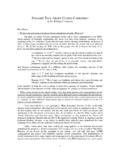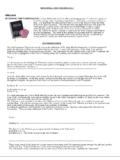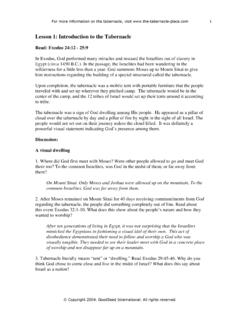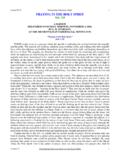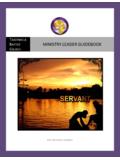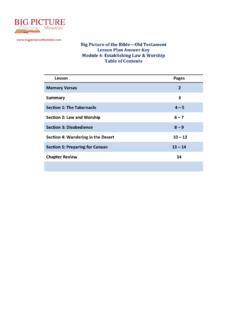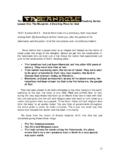Transcription of Christ and the Tabernacle - Our Redeemer, LCMS
1 Christ and the Tabernacle Pas tor Wil liam P. Ter jesen (For this article, I drew upon th e brief and excellent comments about t he typology of the Tabernacle found in Jensen, , Exodus, A Self-Study Guide. Chicago: Moody Press, 1967, pp. 88-93.). KJV John 1:14 And the Wor d was made flesh, and dwelt amon g us, (and we beh eld his glory, the glory as of the only begotten of the Father,) full of grace and truth. This verse presents the essence of Christmas in a nutshell. It speaks of the incarnation of the Son of God. The Word was made flesh, and dwelt amon g us. It doesn't only tell us that God''s Son became incarnate, it tells us that He did so full of grace and truth . His coming is The Great Blessing for humankind. But as we proceed through Advent toward Christmas, I'd like to show you one of the ways that the incarn ation of the Son of God w as prefigured or ty pified in the Old Testament.
2 All knowledgeable Christians know that the Old Testament (OT) prophesied and promised the coming of Christ . But many do n ot realize how freque ntly and in how many different ways these prophecies and promises occur. One form of prophecy is called a type. A type is a person, event, or thing in the OT that is a type of Christ , a shadow of which Christ is the body. For example, when Abraham was about to kill his son Isaac, God stopped h im and provided a ram cau ght by its horns in a thicket. The ram was offered in the place of Isaac (Gen 22). The ram in the story is a type of Christ . Or again, when Joseph was sold by his brothers to the Ishmaelites for 20 pieces of silver (Ge n 37:28) this was a type of Christ who w as betrayed by Judas for 30 pieces of silver.
3 There are many, many types in the OT that find their resolution or fulfillment in the New Testament (NT). Now, back to the verse under consideration. The Word became flesh, and dwelt among Notice the word dwelt . The word in the -1- original Greek, skenoo, meaning to dwell, is c onnected to the idea of liv ing in a tent. The word ten t in Greek is skenos, and we are told that St. Paul was a tentmaker by tr ade, a skenopoios. Some, therefore, have translated the passage, ..and tabernacled (or tented) among us. Now, in that a tent or tabern acle is a temporary dwelling , the word is used in our passage to den ote the temporariness of Ch rist's earthly stay. But it is doing more. John is, by the Holy Spirit, drawing a connection between Christ and the Tabernacle of the OT.
4 For most people the book of Exodus is fairly exciting until you get to chapter 25. Suddenly we are given detail after detail regarding the building and furnishing of the Tabernacle or tent of meeting . Some of this can get rather dry for the average reader, but when we pay careful attention to the information given, we learn that the tabern acle and it's furnishings and ceremonies are all types of Christ and His saving w ork for sinners. In Exodus 25:8 we are told that God commanded the Israelites to build the Tabernacle that He might dwell among them. They wer e to build it according to the exact pattern that God revealed to Moses. It was to be a sanc tuary where G od would manifest His presence among th e people. It was to be a continual object lesson of the presence of the Lord for the people who were wandering in the wilderness toward the promised land.
5 But the Tabernacle was more. It was a type and an anticipation of the incarnation of Christ who became flesh and dwelt (tabernacled) among us, and whom Isaiah calls Immanuel - God with us. The Tabernacle was basically an inner Tabernacle with a courtyard surrounded by a fence with a gate at one end. The fence around the courtyard was made of wooden posts connected by silver bands, with a white curtain going all around the circumference. The front gateway had a veil of blue, purple, scarlet, and white. The inner Tabernacle was made of 48 boards covered with gold and dropped in to sockets sunk into the sand. The ce iling was composed of ten coupled curtains embroidered with cherubim. Over this was a covering of white goats hair, and over that was a covering of ram's skins dyed red.
6 Finally there was a goatskin cov er over the wh ole of it, four cove rings in all. The Tabernacle proper was divided into two rooms. The Holy Place, which was entered -2- frequently, contained the Candlestick or Menorah which had seven lights, the Table of Shewbread upon which was laid 12 loaves of bread that became food for the priests, and the Incense Altar where the daily incense offering was made. Beyond the Altar of Incense, beyon d The Veil, was the Holy of Holies. This room contained the Ark of the Covenant, a chest made of wood covered w ith gold, over w hich lay a solid gold mercy seat with two cherubim. This room was only to be entered once a year by the high priest on the Day of Atonement to pour the blood of atonement on the mercy seat between the cherubim.
7 Outside in the courtyard, just beyond the gate, was the Bronze Altar where sacrifices were offered, and between the altar and the Tabernacle was the laver, filled with water, where the priests would wash. Now, how does all this typify and f oreshadow Christ ? W ell, first of all, the Tabernacle was a tent, as were the dwelling s of all the Israelites as they wandered through the wilderness. As such, it went through everything during the journey that the other tents did, but it was, n evertheless, God's unique dwelling place. So in Christ , who became a man, and dwelt among us, experiencing the adversities and temptations that we experience. Y et, In Him dwelleth all the fu llness of the Godhead bodily ( Col 2:9). Secondly, the details and furnishings of the Tabernacle typify the various phases and aspects of Christ 's saving work on our behalf.
8 For example: The Bronze Altar is a type of Christ our Substitute and Sacrifice. The Laver is a type of Christ our cleansing and regeneration. The Candlestick is a type of Christ the Light of the World. The Table of Shewbread is a type of Christ the Bread of Life. The Incense Altar is a type of Christ our Intercessor and Advocate. The Mercy Seat is a type of Christ our Propitiation. Thirdly, even the order or arrangement of the Tabernacle 's furnishings typify Christ . At one end is the Ark of the Coven ant, the seat of God's gracious presence. At the other end is the Bron ze Altar which typifies the c ross of Christ . Access to the throne of God is given only through Christ 's work for -3- us on the cross. In the Holy of Holies we are surrounded by gold and grandeur with the Shekinah fire manifesting the presence of God above the mercy seat.
9 Then at the other end, at the Bronze Altar we see nothing but blood, suffering, and death; the substitute that dies in the place of sinners. The Bronze altar right beyond the entrance shows us that Christ is our subsitute. The n we proceed to the Laver which shows us that Christ cleanses u s and gives us new life. Inside the Holy Place the Table of Shewbread teaches us to feed upon Christ the Bread of Life, the Candlestick shows us that Chr ist is our light and guide, and Incense Altar indicates that He is our intercessor, through whom our prayers are acceptable to God. When Christ died on the cross the veil of the temple, the separation between the Holy Place and the Holy of Holies, was supernaturally torn in two from top to bottom, indicating that through the atoning work of Christ sinners have access to God.
10 Even the materials of the Tabernacle speak of Chr ist. The wood speaks of His humanity and th e gold, His divinity. White is purity, blue is promise/prophecy, purple is royalty, and red is blood. There is no black in the Tabernacle because black denotes sin and judgment. Now, what has been presented here is admittedly but a brief survey . There is much more that can be said and explored. Interested Bible students might consider studying 1 Corinthians 10:1-11, and Hebrews 8-10 to see how the Holy Spirit develops some of this typology and prophecy. But what we've explored briefly here is enou gh to show that the Ch ristmas truth that in order to save sinne rs, Christ the Word became flesh, and dwelt among us, is not only proclaimed in the NT, but also foreshadowed in the OT, not only in direct prophec ies, but also in many types and figures.
